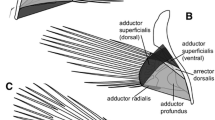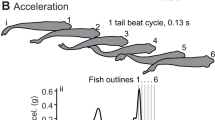Abstract
The common thresher shark (Alopias vulpinus) is a pelagic species with medially positioned red aerobic swimming musculature (RM) and regional RM endothermy. This study tested whether the contractile characteristics of the RM are functionally similar along the length of the body and assessed how the contractile properties of the common thresher shark compare with those of other sharks. Contractile properties of the RM were examined at 8, 16 and 24 °C from anterior and posterior axial positions (0.4 and 0.6 fork length, respectively) using the work loop technique. Experiments were performed to determine whether the contractile properties of the RM are similar along the body of the common thresher shark and to document the effects of temperature on muscle power. Axial differences in contractile properties of RM were found to be small or absent. Isometric twitch kinetics of RM were ~fivefold slower than those of white muscle, with RM twitch durations of about 1 s at 24 °C and exceeding 5 s at 8 °C, a Q10 of nearly 2.5. Power increased approximately tenfold with the 16 °C increase in temperature, while the cycle frequency for maximal power only increased from about 0.5–1.0 Hz over this temperature range. These data support the hypothesis that the RM is functionally similar along the body of the common thresher shark and corroborate previous findings from shark species both with and without medial RM. While twitch kinetics suggest the endothermic RM is not unusually temperature sensitive, measures of power suggest that the RM is not well suited to function at cool temperatures. The cycle frequency at which power is maximized appeared relatively insensitive to temperature in RM, which may reflect the relatively cooler temperature of the thresher RM compared to that observed in lamnid sharks as well as the relatively slow RM phenotype in these large fish.






Similar content being viewed by others
References
Aalbers SA, Bernal D, Sepulveda CA (2010) The functional role of the caudal fin in the feeding ecology of the common thresher shark Alopias vulpinus. J Fish Biol 76:1863–1868
Altringham JD, Ellerby DJ (1999) Fish swimming: patterns in muscle function. J Exp Biol 202:3397–3403
Anderson SD, Goldman K (2001) Temperature measurements from Salmon Sharks, Lamna ditropis, in Alaskan Waters. Copeia 2001:794–796
Bernal D, Sepulveda C (2005) Evidence for temperature elevation in the aerobic swimming musculature of the common thresher shark, Alopias vulpinus. Copeia 2005:146–151
Bernal D, Dickson KA, Shadwick RE, Graham JB (2001) Review: analysis of the evolutionary convergence for high performance swimming in lamnid sharks and tunas. Comp Biochem Physiol Part A Mol Integ Physiol 129A:695–726
Bernal D, Donley JM, Shadwick RE, Syme DA (2005) Mammal-like muscles power swimming in a cold-water shark. Nature 437:1349–1352
Bernal D, Donley JM, McGillivray DG, Aalbers SA, Syme DA, Sepulveda C (2010) Function of the medial red muscle during sustained swimming in common thresher sharks: contrast and convergence with thunniform swimmers. Comp Biochem Physiol Part A Mol Integ Physiol 155:454–463
Bone Q, Chubb AD (1983) The retial system of the locomotor muscle in the thresher shark. J Mar Biol Assoc UK 63:239–241
Carey FG, Teal JM (1966) Heat conservation in tuna fish muscle. Proc Natl Acad Sci USA 56:1464–1469
Carey FG, Teal JM (1969) Mako and porbeagle: warm bodied sharks. Comp Biochem Physiol 28:199–204
Carey FG, Casey JG, Pratt HL, Urquhart D, McCosker JE (1985) Temperature, heat production and heat exchange in lamnid sharks. Mem Southern CA Acad Sci 9:92–108
Compagno LJV (1984) FAO species catalog. Vol 4. Sharks of the world: an annotated and illustrated catalog of shark species known to date. Part 1. Hexanchiformes to Lamniformes. FAO Fish Synop 125:237–249
Coughlin DJ (2002) Aerobic muscle function during steady swimming in fish. Fish Fish 3:63–78
Dickson KA, Graham JB (2004) Evolution and consequences of endothermy in fishes. Physiol Biochem Zool 77:998–1018
Donley JM, Shadwick RE (2003) Steady swimming muscle dynamics in the leopard shark Triakis semifasciata. J Exp Biol 206:1117–1126
Donley JM, Sepulveda CA, Konstantinidis P, Gemballa S, Shadwick RE (2004) Convergent evolution in mechanical design of lamnid sharks and tunas. Nature 429:61–65
Donley JM, Shadwick RE, Sepulveda CA, Konstantinidis P, Gemballa S (2005) Patterns of red muscle strain/activation and body kinematics during steady swimming in a lamnid shark, the shortfin mako (Isurus oxyrinchus). J Exp Biol 208:2377–2387
Donley JM, Shadwick RE, Sepulveda CA, Syme DA (2007) Thermal dependence of contractile properties of the aerobic locomotor muscle in the leopard shark and shortfin mako shark. J Exp Biol 210:1194–1203
Ellerby DJ, Altringham JD (2001) Spatial variation in fast muscle function of the rainbow trout Oncorhynchus mykiss during fast-starts and sprinting. J Exp Biol 204:2239–2250
Gillis G (1998) Neuromuscular control of anguilliform locomotion: patterns of red and white muscle activity during swimming in the American eel Anguilla rostrata. J Exp Biol 201:3245–3256
Hammond L, Altringham JD, Wardle CS (1998) Myotomal slow muscle function of rainbow trout Oncorhynchus mykiss during steady swimming. J Exp Biol 201:1659–1671
Jayne BC, Lauder GV (1995) Red muscle motor patterns during steady swimming in largemouth bass: effects of speed and correlations with axial kinematics. J Exp Biol 198:1575–1587
Johnson TP, Johnston IA (1991) Power output of fish muscle fibres performing oscillatory work: effects of acute and seasonal temperature change. J Exp Biol 157:409–423
Josephson RK (1985) Mechanical power output from striated muscle during cyclic contraction. J Exp Biol 114:493–512
Josephson RK (1993) Contraction dynamics and power output of skeletal muscle. Ann Rev Physiol 55:527–546
Knower T, Shadwick RE, Katz SL, Graham JB, Wardle CS (1999) Red muscle activation patterns in yellowfin (Thunnus albacares) and skipjack (Katsuwonus pelamis) tunas during steady swimming. J Exp Biol 202:2127–2138
Kohler NE, Casey JG, Turner PA (1995) Length-weight relationships for 13 species of sharks from the western North Atlantic. US Fish Bull 93:412–418
Rome LC, Swank D (1992) The influence of temperature on power output of scup red muscle during cyclical length changes. J Exp Biol 171:261–281
Rome LC, Swank D, Corda D (1993) How fish power swimming. Science 261:340–343
Sepulveda CA, Wegner NC, Bernal D, Graham JB (2005) The red muscle morphology of the thresher sharks (family Alopiidae). J Exp Biol 208:4255–4261
Shadwick RE, Syme DA (2008) Thunniform swimming: muscle dynamics and mechanical power production of aerobic fibres in yellowfin tuna (Thunnus albacares). J Exp Biol 211:1603–1611
Shadwick RE, Steffensen JF, Katz SL, Knower T (1998) Muscle dynamics in fish during steady swimming. Am Zool 38:755–770
Shadwick RE, Katz SL, Korsmeyer KE, Knower T, Covell JW (1999) Muscle dynamics in skipjack tuna: timing of red muscle shortening in relation to activation and body curvature during steady swimming. J Exp Biol 202:2139–2150
Syme DA (2006) Functional properties of skeletal muscle. In: RE Shadwick, Lauder GV (eds) Fish physiology. Academic Press, San Diego, vol. XXIII, pp 179–240
Syme DA, Shadwick RE (2002) Effects of longitudinal body position and swimming speed on mechanical power of deep red muscle from skipjack tuna (Katsuwonus pelamis). J Exp Biol 205:189–200
Syme DA, Gollock M, Freeman MJ, Gamperl AK (2008) Power isn’t everything: muscle function and energetic costs during steady swimming in Atlantic cod (Gadus morhua). Physiol Bioch Zool 81:320–335
van Leeuwen JL, Lankheet MJM, Akster HA, Osse JWM (1990) Function of red axial muscles of carp (cyprinus carpio): recruitment and normalized power output during swimming in different modes. J Zool 220:123–145
Wardle CS, Videler JJ (1993) The timing of the electromyogram in the lateral myotomes of mackerel and saithe at different swimming speeds. J Fish Biol 42:347–359
Williams TL, Grillner S, Smoljaninov VV, Wallen P, Kashin S, Rossignol S (1989) Locomotion in lamprey and trout: the relative timing of activation and movement. J Exp Biol 143:559–566
Acknowledgments
This material is based upon work supported by the National Science Foundation under grants IOS-0617384 and IOS-0617403. Any opinions, findings or conclusions expressed in this material are those of the authors and do not necessarily reflect the views of the National Science Foundation. In addition, we express our gratitude to the William H. and MattieWattis Harris Foundation and the National Oceanic and Atmospheric Administration’s Bycatch Reduction and Engineering Program. Logistical support was provided by J. Valdez, S. Adams and T. Tazo. Individuals who assisted in this work include Dr. Nick Wegner, Cpt. Thomas “Cowboy” Fullam, Craig Heberer, Jake Ness, Trevor Young, Bart DiFiore, Lorraine Bohnet, Cindy Jonasson and Victoria Wintrode. We sincerely thank Mr. Thomas Pfleger and Family for their continued dedication toward marine research, conservation and public education.
Author information
Authors and Affiliations
Corresponding authors
Rights and permissions
About this article
Cite this article
Donley, J.M., Sepulveda, C.A., Aalbers, S.A. et al. Effects of temperature on power output and contraction kinetics in the locomotor muscle of the regionally endothermic common thresher shark (Alopias vulpinus). Fish Physiol Biochem 38, 1507–1519 (2012). https://doi.org/10.1007/s10695-012-9641-1
Received:
Accepted:
Published:
Issue Date:
DOI: https://doi.org/10.1007/s10695-012-9641-1




